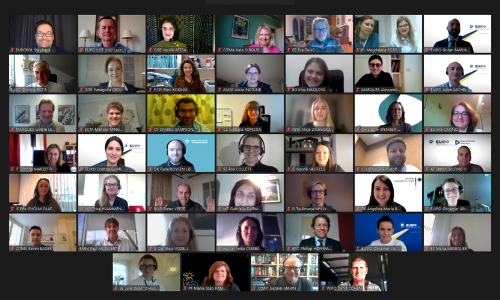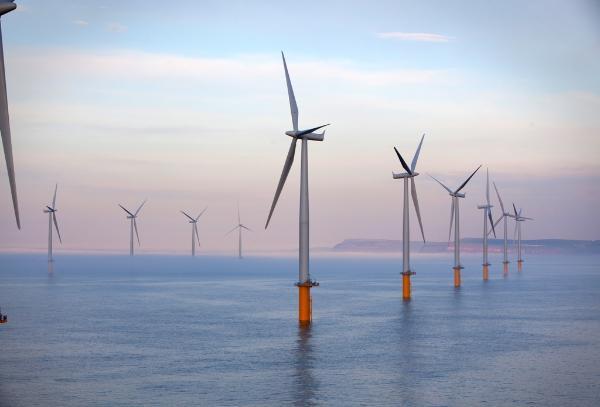Interview with Philip R. Lane, Member of the Executive Board of the ECB, conducted by Annette Weisbach on 22 March 2021
23 March 2021
Let me bring you first to the increased asset purchases. Your asset purchases are now at €21 billion, is that a level the market should get used to now?
As you know, the weekly data are always confounded a bit by redemptions and the week-to-week special factors, but it does reflect our commitment to have a substantial increase in the pace of purchasing. I wouldn’t take any one week in isolation, but of course if you average over several weeks you will see the substantial increase in a consistent way.
If you look at the situation in the bond markets, why are you so concerned? Because if you deduct inflation from the nominal rate, real rates are not such a problem?
We have an inflation forecast which remains quite low, so even in 2023 inflation is only at 1.4% in our forecast. In that context, we would like to see fairly low rates remaining. In fact if we do see inflation pick up − and let me emphasise what really matters with respect to inflation is economy-wide, not just the viewpoint of financial traders, but we would need to see it in firms and households as well − so ideally any pick-up in expected inflation, if it adds to inflation momentum we welcome it. You have to compare the nominal yields we see with respect to the inflation forecast we have, which remains at 1.4% two years ahead.
When we talk about inflation the Fed has opted to allow overshooting. Would you follow the Fed in that respect?
That’s an interesting debate and we have our strategy review and we are still in the middle of that. But the deeper point here is that in a world where essentially lots of central banks have a situation where inflation is too low compared to their target, the universal emphasis and our emphasis has to be to make sure that monetary policy support remains in place until inflation is robustly where we want it to be. We’ve already given forward guidance since September 2019, and we want inflation to robustly converge to our targets. That should provide enough guidance that monetary policy support will be in place until we see that robust convergence.
Would you say the outlook for economic growth and also inflation may deteriorate with what we’re seeing with the spread of the coronavirus (COVID-19) in the big countries, in France and Germany which went straight into lockdown again?
It’s important to emphasise that when we made our recent forecasts a couple of weeks ago, we did allow for some extension into the second quarter. So the fact we are now seeing decisions to have lockdown measures extended into April is not too surprising. I would share the concern and it’s not about the lockdown measures because those just reflect the underlying contest with the virus itself. Until the virus is more contained, until we have more progress on vaccinations, and until it’s clearer these mutations are not going to have a prolonged impact, it’s clearly a risk factor. As we now go into the second quarter, it’s going to be a long quarter. The concerning news is that the virus case numbers are remaining high and are creeping up. On the other hand, we also see that in the second quarter over these three months in April, May and June there will be a lot of vaccinations taking place, so over the course of those three months it will be a contest between progress and vaccinations and other medical progress versus the near-term challenge of trying to get this virus under control.
At the same time, the bond market is especially already playing recovery very strong for the United States. So, are you concerned that there is not a possibility to actually decouple the bond markets because they kind of have a tendency to move in tandem?
This is essentially very much on our minds. And of course, the historic correlation between international bond yields and euro area bond yields is something we can respond to. So, if you like, the fact that we responded in our March decision by stepping up the pace of purchasing is a reflection that we can decouple, if you like, the trend in the international bond market and the trend in the euro area market. I mean, I don’t say that’s 100% decoupling. It’s also the case, as you know, that the increase in yields in recent times in the euro area has not been up to the same scale as in the United States. And in the end, it’s for us to determine, as we did in the March decision, based on the joint assessment of what’s going on in terms of financing conditions, and also what we see in terms of the inflation outlook – that will determine how much we react in terms of the scale of asset purchasing.
Your Dutch colleague stepped out saying that the scaling-up of the purchases should only be for a certain time until we see a substantial calming-down, perhaps, in the market reaction. Would you agree?
I think behind that comment, underlying that comment, and I think our shared view, is essentially it depends on the pandemic. I mean, of course, the programme, the pandemic emergency purchase programme (PEPP), is centred on the pandemic emergency. And as we’ve been discussing, right now there’s a lot of uncertainty about the coming weeks. But as I’ve also emphasised, we also think there’s going to be a lot of vaccinations in these in these weeks and months. And, you know, we’ve tried to add, to recognise, that the uncertainty is a dominant feature. And no matter how the pandemic plays out, whether it plays out with some disappointment, or whether there’s some acceleration of good news, the PEPP is designed to be flexible, and to respond. So, you know, when Klaas was speaking, he provided a conjecture about one pathway. But the more overriding theme, I think, is with uncertainty about the pandemic, the PEPP will adjust in a flexible way to make sure that financing conditions remain favourable and, in particular, that they’ve remained supportive of countering the pandemic shock to inflation.
That brings me directly to the question of favourable financing conditions, because clearly there’s a lot of, you know, interpretation of what that really means and which parameters you’re looking at. Perhaps you could try to explain it a bit more to the markets.
The European economy has a mixed financial system. We know for firms and households, it’s bank-based. But of course, market-based funding is also very important for large corporates, for sovereigns. And so this is why we do take a broad approach where we want to look at what’s going on in terms of market conditions. But also, what we see in terms of the funding conditions facing the customers of banks. What we did also emphasise in the March meeting was the special status or role, if you like, for the risk-free curve, and the sovereign yields as well, because they’ve played such an important role in the overall financing conditions of the euro area. And also, it’s obvious when we think about our asset purchasing, that’s where we operate on, we operate on the risk-free curve and the sovereign yields. And that’s why we pay particular attention when we see a significant movement in these yields, as we did over recent weeks.
I had the feeling that during the last meeting, the outlook for the economy was less negative than previously, would you stick to that assessment, also given the situation surrounding the virus now?
So I think we made two statements about that. One is that in the near term, this downside risk was prominent. So the downside risk about whether the pandemic would quickly be controlled remains the dominant issue in the near term. But we also said that the overall balance of risk was becoming more balanced because compared to December, we have the avoidance of a more difficult Brexit outcome. We’ve had the stimulus, fiscal stimulus coming from the United States, we’ve had better data in relation to the end of 2020 in quarter three and quarter four. So we’ve had several pieces of news that would have, if you like, renewed confidence in the medium-term outlook. But at the same time, as we’ve been talking about, we do have this near-term uncertainty, this near-term concern about the pathway for the virus.
Yes that’s clearly the case, but the response from the United States or from the European Union, if you compare that to the United States, we are lagging far behind, are you concerned that the United States will come out of that crisis with a big bang because of their fiscal stimulus. And Europe has to again, like after the last crisis, face many years until we actually recover?
So let me break that into two different questions. One is there will be positive spillovers from the United States. The fact that there is a significant stimulus in the United States will boost global GDP, will boost exports from the euro area. Of course, the initial impact was visible more in the financial markets. But over time, as the stimulus gets rolled out, it will be a significant engine for the world economy. I would emphasise, of course, given the nature of the United States, that you can have very large fiscal packages embodied in a single piece of legislation. As you know, in the European situation, we have a mix. We have 19 national fiscal policies, and then we have the joint fiscal action. So maybe it’s worth keeping in mind the statement from the Eurogroup from a couple of weeks ago, which heavily emphasised that the Eurogroup collectively are paying close attention, and essentially committing that there will be an agile fiscal response in recognition that as this pandemic unfolds, it is very important that fiscal support is maintained, and that there is no early exit. So I think, then maybe you see every week or every few days, a fiscal announcement coming from individual member countries. So I do think the forward guidance is there, from the Eurogroup, that the scale of fiscal policy will respond to the unfolding of the pandemic. But I do think it’s for all of us to reflect; the parameters of the fiscal debate have clearly moved with the US decision. And it is an important issue for European policymakers to reflect upon about how to calibrate the European fiscal response, and to make sure it’s sufficient to get through this pandemic.
So in other words, the longer the pandemic lasts, the higher the pressure also on Brussels to think about increasing the package?
Well, I think again, there’s a range of possibilities. And, of course, we also have to do the basics of making sure that the recovery plans are finalised; that’s been a heavy focus of work in recent times. So again, the combination of national fiscal policy and EU level really has to be set so that as the pandemic unfolds, fiscal policy is agile. And I think that is the commitment of the Eurogroup.
The fiscal response clearly is a huge step for the European Union with these Next Generation EU bonds. And this would probably also mean that we are going to have a proper European yield curve at one point in time. Is that something which makes monetary policy easier?
Of course, the significant bond issuance that’s envisaged on the Next Generation EU, and the fact that it’s going to have a whole range of maturities will be helpful in deepening the stock of safe assets in the euro area. It will be an important reference point. But I would try to avoid arguing that there needs to be one single reference point in thinking about the pricing of European assets. So I think the nature of Europe is it’s always going be a mix of EU level and national level fiscal policy, and how we think about the stock of safe assets, how we think about reference points, I think will reflect that. As we’ve talked about earlier on, you know, we essentially are jointly looking at the risk-free curve, where we often use the overnight index swap curve as a kind of useful proxy for that. But we also look at the whole constellation of sovereign yields. Now, when we have more EU issuance, we already have the SURE bonds. I think it’s super informative and super helpful to have that. But I think the overall message is, the stock of safe assets in Europe is going up, not just because of the EU level issuance, but because of the decline in risk premia for many sovereigns in the euro area.




